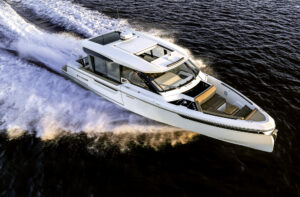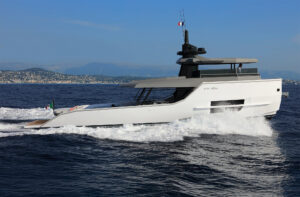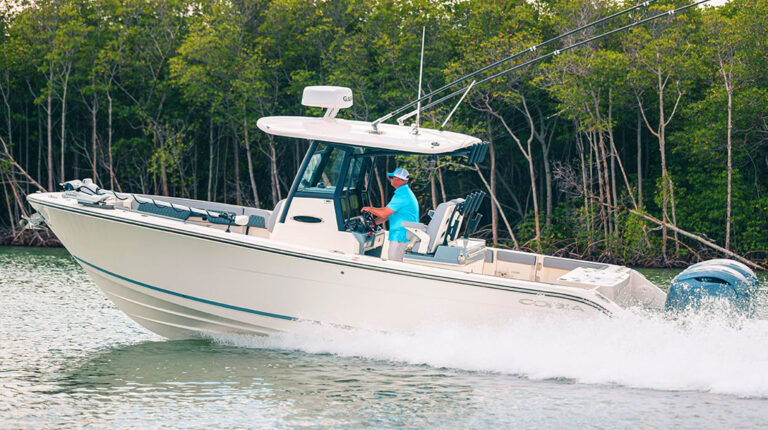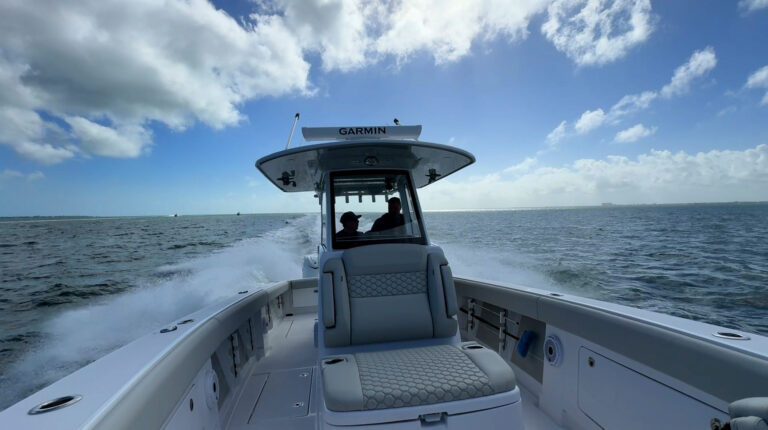Photos by Capt. Bill Pike
Okay, I admit that the title of this article is just a teeny bit misleading. I mean, really, nothing lasts forever. Not even Jack LaLanne. But I do know a few tricks that the average boater can use to make his engines—be they gasoline or diesel—last for a very long time. Maybe even as long as the boat itself.
Prefer to listen? Listen to this article in the player below:
One question I was often asked when I was a working mechanic is how long a marine engine should last. You’ll hear lots of numbers bandied about in answer to that but the truth is there is no answer. How long an engine lasts depends on so many variables that no one could accurately predict engine life with any degree of accuracy. But we can say a few things about engine life in general.
First, diesel engines typically last longer than gasoline engines. There are two main reasons for this. One, at a given boat speed they turn fewer revolutions, usually about a third fewer. When an engine turns fewer revs per mile, pistons make fewer trips up and down the cylinders and valves open and close less often. Ergo, less wear.

The other reason is that diesel fuel contains oil, and so it not only provides fuel for combustion but also for lubrication. Gasoline is fuel and nothing else. Moreover, as we all know, diesels burn less fuel per mile traveled than gasoline engines, and the most reliable indicator of an engine’s life is the amount of fuel it burns. Remember that, because we’re going to come back to it.
So let’s talk about what happens to geriatric boat engines. Some of them rack up so many hours that their piston rings and/or valve guides wear, allowing lubricating oil to get past them and into the combustion chamber, where it’s burned, along with fuel. The result is a rather embarrassing cloud of blue smoke but the engine still runs, often surprisingly well. However oil consumption only gets worse, and inevitably it will get to the point that it’s either too bothersome to put up with or the spark plugs start fouling with oil residue and the engine begins to miss, and eventually won’t start.
There’s another wear-out scenario, one in which the core engine—pistons, crankshaft, bearings, valves, etc.—is in good shape but the ancillaries begin to fail for a variety of reasons, usually associated with corrosion. By ancillaries I mean things like water pumps, carburetors/fuel-injection systems, exhaust elbows, and ignition components. This scenario usually leads not so much to a blue cloud as it does to hard starting, poor performance, and big repair bills.

If you plan on keeping your boat for a long time and you don’t want to suffer the financial pain of repowering it, you’re going to have to address both of these scenarios. Let’s start with the first one.
We all know that the best way to keep an engine from wearing out is changing the lubricating oil at proper intervals, right? But what is a “proper interval?” It starts with the engine manufacturer’s recommendation, which is for engines subject to normal use; that is, not things like unusually heavy loads, high temperatures, or dirty air. Assuming your engine does not fall into that category, there is absolutely no benefit to changing your oil more often. The efficacy of modern lubricating oil—even the cheapest API-rated oil—is such that there is nothing to gain by replacing it before its allotted time; doing so will not make your engine last longer. You’ll just waste money and create hazardous waste that needs to be disposed of.

It is theoretically possible to subject your engines to such severe operation that you need to reduce the oil-change interval—possible but unlikely. The most likely causes of “severe operation” in boats are extended low-speed operation, where fuel is incompletely burned, and unusually heavy loads. The former is unlikely to be a problem in modern engines due to electronic controls, and the latter is even more rare, unless your convertible happens to double as a long-liner. In other words, most of us should just stick to the factory recommendations. With one exception …
Diesel-powered boats that venture outside of North America may encounter fuel containing high levels of sulfur, which when burned transmogrifies into extremely corrosive sulfuric acid that accumulates in the lubricating oil. Filters won’t remove it; the only way to get rid of it and prevent it from attacking bearings and other soft-metal components is to replace the oil. If you go to the out islands of the Bahamas or Mexico or beyond and want your diesel engines to last, you need to monitor the sulfur content of the fuel you purchase and act accordingly. You can buy an inexpensive test kit (www.titanlab.com) that will alert you to high levels of sulfur in your lube oil.
What about synthetic oil? Will it increase the life of an engine? Synthetics have been shown to lower wear rates compared to petroleum oil—exactly how much varies. Whether this translates into longer engine life is debatable. My personal opinion is that any good API-rated lubricating oil will do almost as good a job at a fraction of the cost. But if the old cost-benefit computation doesn’t matter to you, go for it.

One final note about oil: if you want your engines to last, make sure that whoever changes it does it the right way. For most boaters the engine manufacturer’s maintenance recommendations (which, by the way, apply whether you use petroleum or synthetic oil) mean changing oil once a year. If your boat will stay where it gets cold, change the oil as close to winter lay-up as possible to prevent over-the-winter damage from the contaminants that naturally accumulate in it. Ideally, drain your oil right before the boat is hauled, refill, then run the engine for a minute or two to make sure everything is coated with clean oil. When you start the boat in the spring, remember that all of the oil has drained into the pan and let the engine idle for a minute or two to recirculate everything. If you don’t, you could produce as much wear in five minutes as all of your running does for the rest of the year.
Always drain oil when it is warm. Modern multi-viscosity oil does not need to be hot to flow easily but oil should be well above the ambient air temperature. If you delegate this job to a mechanic be aware that some can be less than scrupulous about this, draining the oil whenever they have a free minute—which may be when the engine is stone cold. Draining oil from a cold engine can leave as much as a half-quart of dirty oil behind, which will let all that acid and water vapor work its magic over the long winter. Always change the oil filter when you change the oil, too; it can hold as much as a quart of dirty oil.
So, if changing your oil more frequently won’t significantly increase the life of your engines, what will? Remember that sentence back at the start of the article? To repeat: The most reliable indicator of engine life is the amount of fuel an engine burns. This is why turbocharged and intercooled diesels don’t last as long as naturally aspirated ones as shown on these pages—they burn more fuel. So the easiest way to extend engine life is to throttle back, at least to the most efficient cruising speed if not beyond. It’s really that simple. Of course, there are other helpful operational guidelines, things like making sure the lubricating oil—not the coolant—is warm before you put a load on the engine and giving the engine a minute or two at idle to cool before shutting down. Most are common sense, and frankly, a lot easier to do than actually slowing down.

And what of that second scenario—the one where the core engine is intact but the ancillaries fail? Whether your engines are old or new, gasoline or diesel, the components that reside outside of the core engine are constantly at risk due to the salty marine environment. Corrosion is the main culprit here, and the battle against it is constant and never-ending. You should inspect your engine visually every month for corrosion, and when you find it, remove it down to bare metal, prime the area, and paint it with manufacturer-approved engine paint. The key to corrosion is catching it early and treating it aggressively, before the component is so deteriorated that it has to be replaced. This is especially true of bolts and other fasteners. Once they’re rusted they may no longer do their job properly, leading to leaks and more corrosion and maybe even overheating, and you’ll pay hell getting them out.
The point where the greatest corrosion tends to take place on an engine is the exhaust elbow where salt water leaving the engine block mixes with hot exhaust gases. On many newer gasoline engines and most diesels, this elbow is made of stainless steel, which renders corrosion far less likely. If your engines have cast-iron manifolds, their life expectancy can be as short as two years, depending on the ambient water temperature and salinity. When an elbow fails, the result can be anything from a messy leak (and more corrosion) to overheating. The only way to stay on top of these elbows is to remove the exhaust hose leading to them and look inside, something worth doing once a year.
Overheating is a principal threat to your engine’s longevity. Repeated or prolonged overheating raises the temperature of internal components and can deform them, causing further complications ranging from coolant in the oil to more serious overheating. Anything you can do to minimize or avoid overheating will increase your engine’s longevity, including replacing engine coolant and sacrificial anodes at the recommended interval. Underway, keep an eye on your coolant temperature gauges and ensure your engine alarm system, annoying though it may be, is operating properly. Periodic inspection of your raw-water strainers is important for the same reason. And when an alarm does go off, reduce engine speed or shut down altogether. Continuing to run, even slowly, can cause internal damage that may not be readily apparent but may rear its ugly head over the long term. Treat every overheating incident as a potential reduction in your engine’s lifespan.
No discussion of engine life would be complete without mentioning the topic of preventative maintenance—replacing or repairing things before they actually need it. This is a topic rife with controversy because the benefits that may accrue by replacing something that might go wrong can be offset by problems due to improper installation and disturbing that which would have been better left undisturbed. My own view is succinctly summarized by the aphorism, “If it ain’t broke, don’t fix it.” Instead of whipping out the old tool kit, keep a sharp eye out for symptoms of trouble and take action when the problem makes itself apparent.
Today’s gasoline and diesel engines exhibit a level of reliability unimagined only a decade ago. That means there’s a lot less for you to do. But it doesn’t let you totally off the hook. If you’re in a committed long-term relationship with one particular boat and her engines, a well-thought-out plan of prudent operation and maintenance can forestall an untimely divorce.










